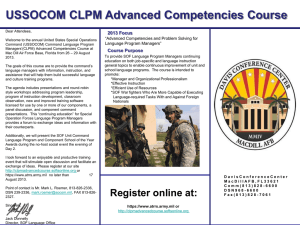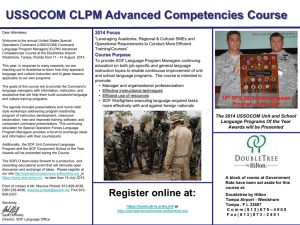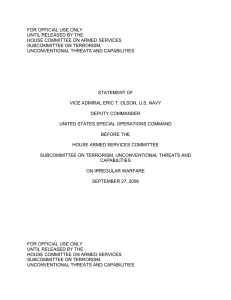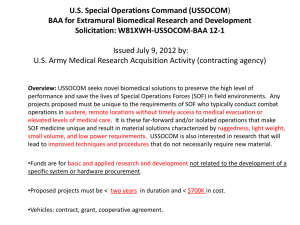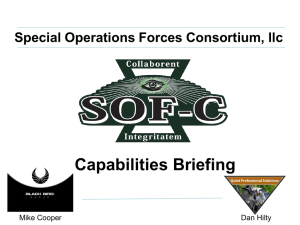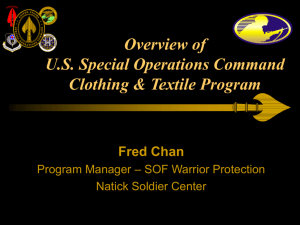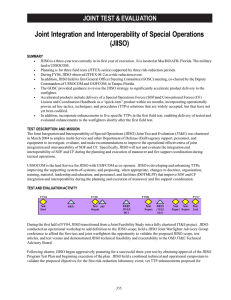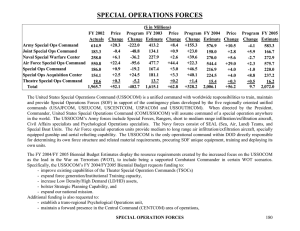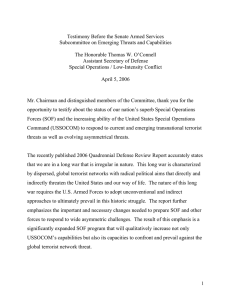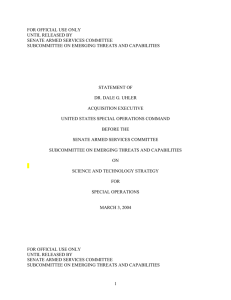For Official Use Only Until Released by the Senate Armed Services Committee
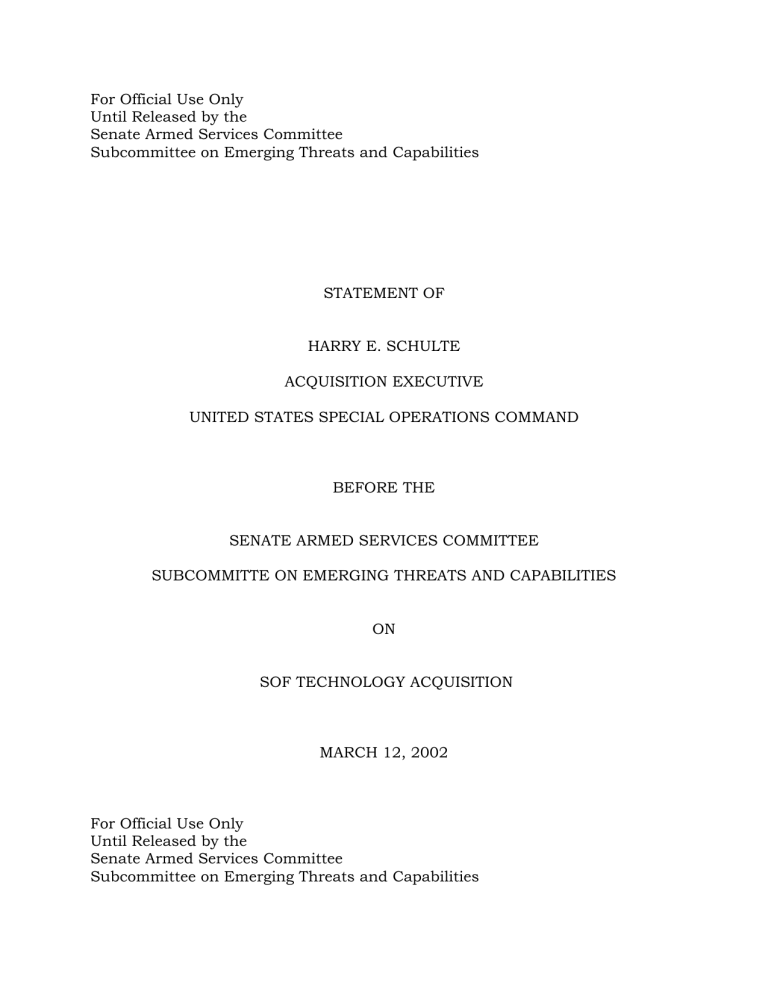
For Official Use Only
Until Released by the
Senate Armed Services Committee
Subcommittee on Emerging Threats and Capabilities
STATEMENT OF
HARRY E. SCHULTE
ACQUISITION EXECUTIVE
UNITED STATES SPECIAL OPERATIONS COMMAND
BEFORE THE
SENATE ARMED SERVICES COMMITTEE
SUBCOMMITTE ON EMERGING THREATS AND CAPABILITIES
ON
SOF TECHNOLOGY ACQUISITION
MARCH 12, 2002
For Official Use Only
Until Released by the
Senate Armed Services Committee
Subcommittee on Emerging Threats and Capabilities
Madam Chairwoman and Members of the Committee:
I’m Harry Schulte, Acquisition Executive for the United States Special
Operations Command (USSOCOM). It is an honor and a privilege to report to you on the topic of Special Operations Forces (SOF) acquisition and technology.
Congress, through Title 10 U.S. Code, Chapter 6, Section 167, empowered the
USSOCOM to develop and acquire Special Operations-peculiar equipment, material, and services. We have implemented streamlined and cost effective processes to provide our SOF soldiers, sailors, and airmen with the technology and equipment they need to execute their warfighting and peacekeeping missions.
Our fundamental acquisition philosophy in USSOCOM is to field, in an expedited manner, an 80% solution while working with our warfighters and industry to address the remaining 20% of the requirement. We leverage the three Services, Defense Advanced Research Projects Agency (DARPA),
Department of Energy (DOE), and other agency research and development programs to look for technology to apply to our SOF warfighter needs. We survey industry and use a “buy and try” approach for government and commercial off-the-shelf items. Our warfighters perform early user evaluations of these potential systems; then we modify, test and field acceptable products.
We enjoy an exceptionally close working relationship with our SOF operational users. They are willing and anxious to accept the timely increase in capability provided by the 80% solution, and their high state of training and experience enables us to accept risk in our fielding decisions. This process enables
1
USSOCOM to shorten the typical acquisition cycle and rapidly insert technology to provide our SOF critical warfighting advantages. The acquisition organization’s collocation with headquarters USSOCOM, daily contact with our warfighters, our relatively small size and short decision cycles, and the support we receive from the Services, Department of Defense and Congress are major contributing factors to our effectiveness.
ACQUISITION PROCESS EXAMPLE
I will briefly discuss the acquisition process for one of our recent successes, the Multi-Band Inter/Intra Team Radio (MBITR). The MBITR is currently fielded with our Special Operations force in Afghanistan. The MBITR acquisition program was completed in less than three years. The significant acquisition timeline compression was accomplished primarily because of the close government, industry, and operational user relationships established early in the program. Dialog between the program office and candidate developers led to definition of suitable technologies to satisfy MBITR requirements. A competitive, cost sharing development contract with production options was awarded to Thales Communications, Inc of Clarksburg,
Maryland. USSOCOM accepted cost accountability for management and the contractor assumed total risk for the functional design.
After contract award, the contractor, operational users and other
Government agencies participated in a joint Integrated Product Team (IPT).
The IPT ensured strict adherence to multi-service customer requirements, interoperability standards, and the joint technical architecture. USSOCOM
2
used extensive early user evaluation of prototype radios to limit test incidents typically experienced in Operational Test and Evaluation (OT&E). Prototype radios were released to the Joint Interoperability Test Center (JITC), Navy
Special Warfare and Marine Corps Force Reconnaissance units for evaluation in mission scenarios. The evaluators employed the MBITR in diving, high altitude parachute, and ground operations. During these evaluations, the contractor was allowed full visibility, thereby shortening the development learning curve and facilitating rapid modification of the test articles prior to
OT&E. The close working relationship among program stakeholders minimized acquisition cycle time and produced a topnotch product.
Over 8,000 MBITR radios have been fielded to SOF, other service users and coalition users. Our warfighters in Afghanistan report this new radio is proving to be exceptionally effective in the joint operations environment.
OUR CHALLENGE
Although our people are certainly SOF’s most important asset, maintaining and improving materiel capabilities remains SOF’s most difficult challenge. SOF must keep its equipment up to date, while keeping the cost for sustaining its war-fighting systems under control. SOF depends on leadingedge technology to provide the critical advantage and to support participation in a growing number of technologically complex missions and operations. Our challenge is to find ways to modernize or sustain legacy systems when it makes sense, while developing technological bridges with our industry, service, interagency, and international partners.
3
I will now briefly discuss our Urgent Deployment Acquisition (UDA) process and a few of the standout technologies used in Operation Enduring
Freedom. Then, I’ll discuss how we invested Defense Emergency Response
Funds (DERF); what’s new in the budget and, promising technologies for the future.
OPERATION ENDURING FREEDOM
Our current top priority is supporting Special Operations Forces engaged in Operation Enduring Freedom. We have implemented processes to identify, validate, and rapidly acquire Special Operations-peculiar materiel solutions to emerging requirements of our SOF warfighters. The regional CINCs forward
Combat-Mission Needs Statements (C-MNS) to USSOCOM. The USSOCOM staff forms a rapid response team to validate the mission need and develop a plan of action. This team provides their recommendation to our Deputy CINC within 48 hours. When the DCINC approves a C-MNS, resources are identified, and I initiate a program to address the warfighter’s need. Our streamlined acquisition procedures are further streamlined as fielding warfighter C-MNS solutions is our top priority. These UDA programs are yielding exceptionally positive results. I’ll briefly highlight three of them.
Laser Targeting Devices. In seven days we were able to contract, acquire and deliver into the area of operations an initial operating quantity of new technology laser targeting devices. These binocular-like electro-optical devices are being used by SOF ground forces to observe and precisely measure the three-dimensional coordinates of distant targets such as cave entrances.
4
Through our joint communications systems, our forces on the ground relay those coordinates to Air Force and Navy flight crews for delivery of precision guided munitions. This system has proven to be a significant combat multiplier.
Aerial Leaflet Delivery Bomb. We are fielding an aerial bomb leaflet delivery system for deployment of PSYOP leaflets by F-16 and F-18 fighter aircraft. At the request of CINCCENT, we initiated the project in October and will accomplish an initial operating capability in theater later this month.
Man-portable UAVs. Unmanned aerial vehicles (UAV) are providing significant capabilities and value. Technology has matured to the point where man-portable UAVs can provide ground forces an organic capability to remotely conduct local reconnaissance and surveillance missions. This capability will allow operators in small teams to look over the next hill and assess enemy activity and avoid unplanned engagements with larger enemy forces. We are continuing to explore sensor and miniaturization technologies to enhance this combat multiplier.
DEFENSE EMERGENCY RESPONSE FUNDS
In response to the September 11th terrorist attack, the Secretary of
Defense authorized Defense Emergency Response Fund (DERF) obligation authority to resource immediate requirements. These critically needed funds are used to resource our urgent deployment acquisitions and accelerate current programs prioritized by Theater Special Operations Commands and
USSOCOM Component Commanders. Some of these DERF programs are:
5
Night Vision Electro-optical Equipment. SOF enjoys a decided advantage in this area…it has been said, on numerous occasions, “SOF owns the night.”
While this is currently true, similar commercial technology is becoming readily available throughout the world and it is very likely that our “ownership of the night” will erode over time unless we continue to push the envelope. More importantly, we need to carefully control release of our technologies to other countries and keep pushing the envelope on precision laser targeting, thermal imaging, thermal weapon sights, and night vision device technologies.
Aircraft Survivability and Capability Enhancements. Accelerated efforts include directional infrared countermeasures, enhanced situational awareness, and several MH-53 sustainment modifications. To enhance AC-130 Gunship capabilities, the Air Force recently integrated a capability to allow direct real time streaming of Predator UAV video data to the gunship. This rapid technology insertion improved gunship effectiveness by shortening the engagement chain, enabling our crews to place fire and steel precisely on target in a very short time.
Other DERF efforts include: deployable secure local area networks; blue force tracking devices; all terrain vehicles; remote observation sensors; U.S.
rifles modified to fire foreign ammunition; standoff explosive detection systems; man-portable chemical decontamination equipment; joint interoperable SOF radios; body armor; lightweight environmental protection combat uniforms; and, joint threat warning systems for operators and platforms.
6
As we expand to other areas in our global war on terrorism, USSOCOM will continue to acquire technologies that provide our forces the ability to fight and win in varied environments. We have the process in place to accomplish this task.
WHAT’S NEW IN THE BUDGET
Key transformation initiatives in our budget focus on air and underwater capabilities to infiltrate and exfiltrate SOF into denied areas and survivability of our platforms and forces. Our flagship programs continue to be the CV-22
Osprey and Advanced SEAL Delivery System. Other major initiatives are: maintaining our MH-53 fleet through FY07; a twenty year service life extension program for the MH-47; enhancing psychological operations capabilities; adding up to 4 AC-130Us to our fleet of gunships; development of a directed energy weapon for the gunship; and multiple programs to enhance SOF aircraft survivability.
TECHNOLOGIES FOR THE FUTURE
On the horizon we see promising technologies maturing that will help keep SOF on the cutting edge. USSOCOM is working closely with industry, labs, and academia to insert those into our technology thrust areas: signature reduction; high bandwidth/reachback communications; underwater communications; unmanned systems; batteries/fuel cells; remote sensing; advanced training systems; bioengineering; and, directed energy weapons.
These thrust areas address the technology gaps we see and offer SOCOM the greatest opportunity for technological payoff.
7
CONCLUSION
The DERF resources you provided enabled USSOCOM to rapidly acquire and deliver high technology products to our deployed forces that made an immediate difference. Without DERF, and the flexibility it gives us, many of our urgent deployment acquisitions, which have proven to be effective combat multipliers in Afghanistan, would still be program plans awaiting approval and resourcing.
USSOCOM has worked hard to wisely use its modernization resources to sustain systems when it makes sense, to integrate new technologies into legacy systems, and to acquire new technically advanced systems that are enabling our combatant CINCs to win the war on terrorism. We intend to continue our focus on modernization and transformation challenges to ensure our ability to rapidly adapt to changes in technology, the operational environment, and ensure we always provide our SOF operators with the decisive advantage.
8
